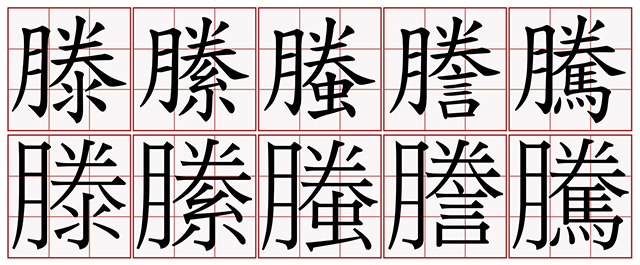
What is shown above is a trivial difference in a two-component structure that is present in many ideographs, such as 滕 (U+6ED5), 縢 (U+7E22), 螣 (U+87A3), 謄 (U+8B04), and 騰 (U+9A30). This difference is, of course, unifiable. What this article is about is consistency within a standard, mainly referring to the source standards from each region. The focus of this article is on the forms used in ROC (Republic of China; 中華民國 Zhōnghuá Mínguó), which is more commonly referred to Taiwan (臺灣 or 台灣 Táiwān).
First, we can examine the representative glyphs in the Unicode Code Charts. Below are excerpts for these five ideographs:

The pattern that should emerge is that the conventions for Chinese—meaning for the G (PRC), H (Hong Kong SAR), and T (ROC) representative glyphs—entail the use of the form on the right whereby the lower-right curved stroke of the upper-right component touches, but does not pass through, the lower horizontal stroke. The conventions for the other regions—meaning for Japan, Korea, and Vietnam—entail the use of the form on the left whereby the stroke in question penetrates the lower horizontal stroke and touches the upper one.
However, the T-Source presentative glyph for U+8B04, which corresponds to CNS 11643 Plane 1 0x754E, breaks this pattern by using the form on the left.
Things become more interesting, and perhaps more apparent, when we examine Taiwan’s MOE standards for typeface styles, specifically those for Kaishu (楷書) and Songti (宋體) styles:

Again, the representative glyph that corresponds to U+8B04 breaks the pattern, but only for Songti style. The fact that the representative glyph for Kaishu style does not break the pattern strongly suggests that this is a genuine error. The Taiwan MOE index number for the ideograph that corresponds to U+8B04 is 103878, and you can inspect for yourself the relevant pages in the Kaishu and Songti styles. Although I don’t show the representative glyphs in this article, this error is present in the Fangti (方體) style, but not in the Lishu (隸書) style.
Lastly, this representative glyph error is present in CNS 11643-2007, as shown below:

Though not shown in this article, the representative glyphs in CNS 11643-1986 and CNS 11643-1992 are correct.
Of course, this issue has been reported, via IRG N1994 and L2/14-130.
Many thanks to Kuang-che Wu (吳光哲) for finding this relatively obscure error.
As the title of this article states: close, but no cigar. ☺

The more recent article includes a comment by me that provides a reply from the Taiwan MOE that confirms this error.